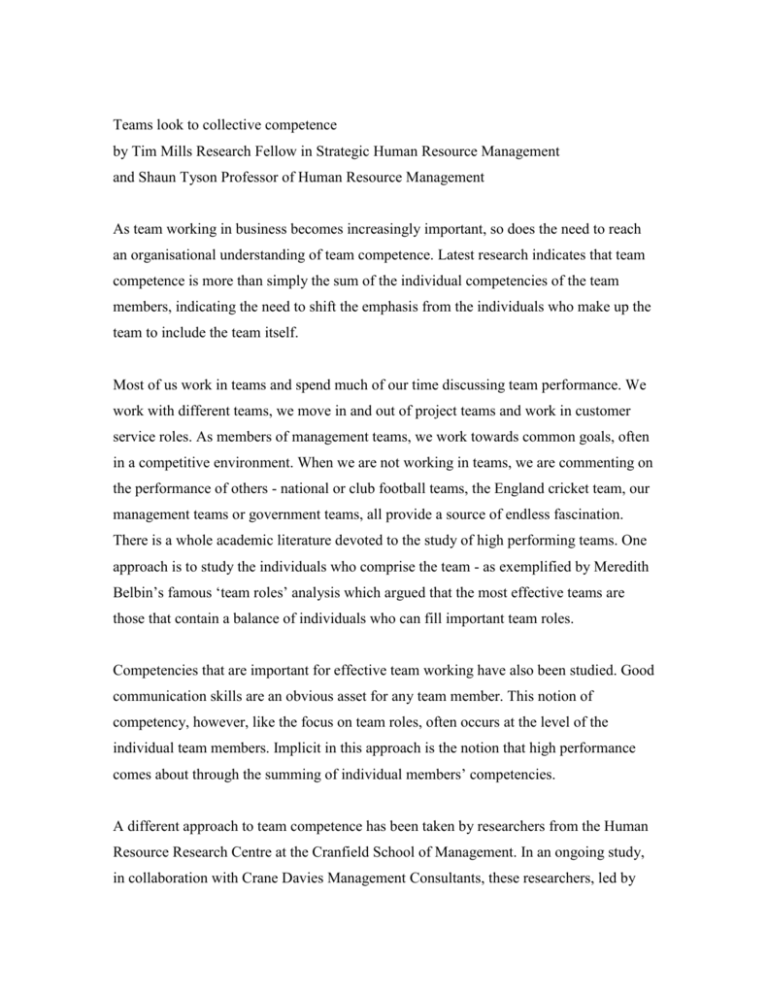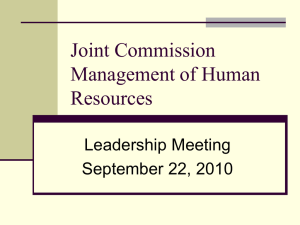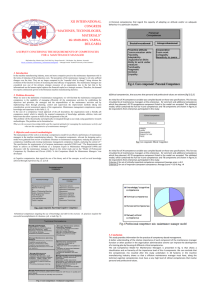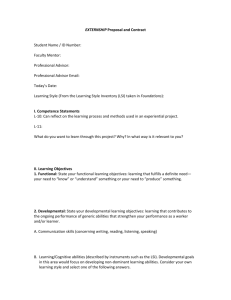Teams look to collective competence
advertisement

Teams look to collective competence by Tim Mills Research Fellow in Strategic Human Resource Management and Shaun Tyson Professor of Human Resource Management As team working in business becomes increasingly important, so does the need to reach an organisational understanding of team competence. Latest research indicates that team competence is more than simply the sum of the individual competencies of the team members, indicating the need to shift the emphasis from the individuals who make up the team to include the team itself. Most of us work in teams and spend much of our time discussing team performance. We work with different teams, we move in and out of project teams and work in customer service roles. As members of management teams, we work towards common goals, often in a competitive environment. When we are not working in teams, we are commenting on the performance of others - national or club football teams, the England cricket team, our management teams or government teams, all provide a source of endless fascination. There is a whole academic literature devoted to the study of high performing teams. One approach is to study the individuals who comprise the team - as exemplified by Meredith Belbin’s famous ‘team roles’ analysis which argued that the most effective teams are those that contain a balance of individuals who can fill important team roles. Competencies that are important for effective team working have also been studied. Good communication skills are an obvious asset for any team member. This notion of competency, however, like the focus on team roles, often occurs at the level of the individual team members. Implicit in this approach is the notion that high performance comes about through the summing of individual members’ competencies. A different approach to team competence has been taken by researchers from the Human Resource Research Centre at the Cranfield School of Management. In an ongoing study, in collaboration with Crane Davies Management Consultants, these researchers, led by Professor Shaun Tyson, have focused their attention at the level of collective competence. This approach differs from those mentioned previously because it assumes that high team performance emerges from the collective processes operating within the team. Team competence, therefore, is more than simply the sum of the individual competencies of the team members. Clearly, there are many different types of teams. In the first stages of this research project, teams from both business and non-business environments were studied to try to capture both the differences and similarities in collective competence. Data using a variety of research methods were collected from senior managers, footballers, project managers, jazz musicians and virtual team members. This rich source of information was then carefully analysed to create a putative model that describes a number of collective team competencies. But is it really legitimate to compare footballers with senior managers? Is what they do so different as to make comparisons pointless? The researchers believe comparisons can be made given certain considerations. They suggest, backed up by other research, that all teams can be described in terms of certain underlying structural characteristics. For example, any team by definition faces a collective task and the level to which this task is prescribed is likely to determine the type of team processes that are important. Consider a rowing team: eight rowers who are required to pull together in harmony. High performance for them is unlikely to be enhanced, for instance, by creativity. Jazz groups, on the other hand, define high performance in terms of creativity. For them, the task they face is less structurally determined at the outset. Thus, the type of team process that is important for success is partly determined by this task structure. For one team creativity on task is a necessity, whereas for the other it would be a disaster. Similarly, teams can exhibit different levels of stability. Some teams may work together over an extended period - football teams, for example, are relatively stable. A common allegation made against numerous England team managers in the past is that they have failed to produce a settled side. This complaint recognises the importance of allowing players to develop an understanding of their team-mates so that they may develop ways of playing together successfully. For football teams it is important that stability is allowed to facilitate collective competence. Other teams, however, are not afforded this luxury. Take the virtual team in business team members may be thrown together at very short notice from the four corners of the earth. Given a one-off project, these teams are expected to perform successfully from day one. This lack of team stability is likely, in part, to determine those processes that will enable collective success. Communication - a core collective competence The teams chosen for study in this project provided a range of team stability and task structure. The early findings suggest that many team competencies are core to all teams. The team-task environment seems to determine the processes by which these competencies are achieved, rather than simply to define which competencies are required. Let us consider communicating - a competency the researchers consider is a core collective competence. Stable teams find ways of achieving competent communication over time. Footballers work on set plays - through practice they develop what they perceive as a sixth sense concerning the way they read a team-mate’s intentions. Psychologists would describe this perception as the result of cognitive processing at an automated level, possible because of the learning opportunities the training ground environment affords them. Unstable teams, like jazz groups, can’t develop such processes within the team. They often come together for one-off performances and they literally have to bring communication knowledge to the party. This is achieved by the jazz community developing a commonly understood set of generic communication patterns through time spent working with particular individuals, or years of practising with like-minded players in jazz dives. It is the level of stability that defines the process by which the competency is achieved for both footballers and jazz musicians. Communicating is just one of around seventeen collective competencies that currently make up the team competency model. Much of the research into management, project and virtual teams has revealed commonalities with non-business teams. The collective competencies that have emerged can be clustered according to whether they contribute to the psychological environment within which the team operates, or directly to the successful facilitation of the task. Assessing team competence The next stage of the project will be a survey to validate the model. The researchers intend to sample approximately 1000 team members, predominantly from business environments. This survey data will allow for the kind of rigorous statistical analyses required to confirm the accuracy of the initial findings. An exciting spin off from the validation phase of this project will be a new Team Competency Assessment Questionnaire which will enable teams to assess their collective strengths and weaknesses. Reliable information relating to a team’s collective competence would prove invaluable for any team development programme. Along with highlighting areas of weakness, the instrument would provide a metric that could be used to chart a team’s progress. The notion of individual competencies is accepted as an invaluable tool for integrating many aspects of an organisation’s HR function. From recruitment and selection, through appraisal and on to rewards, competencies provide the framework upon which to structure understanding of individual performance. Team working is becoming increasingly important to many organisations as the benefits become apparent. It is vital that an organisational understanding of collective or team competence is reached if these benefits are to be fully obtained. To achieve this the researchers believe it is important to shift the emphasis from the individuals who make up the team to include the team itself. For further information about the research, or to take part in the survey stage of the study, please contact Tim Mills at Cranfield School of Management, e-mail: t.i.mills@cranfield.ac.uk or telephone: 01234 751122.








